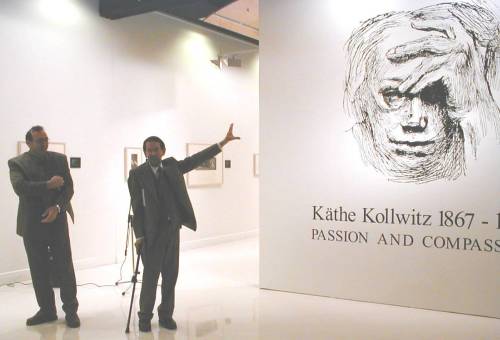
with the Mayor of Moreland, Councillor Joe Ficarra
This exhibition opened at Melbourne's Counihan Gallery In Brunswick, 233 Sydney Road, on Thursday 16 October 2003. It will run to Sunday 9 November.
Most of the works are from the collection of cultural historian and activist Robert (Bob) Smith. In opening the exhibition, Bob took issue with advance publicity referring to him as a collector, saying that this has unwelcome connotations of private ownership, personal prestige and corporate image-making. Bob said he acquired particular works of art over the years because they appealed to him for the values and humane attitudes they embody in graphic images. He prefers to look on himself as a custodian of art works that without deliberate forethought he acquired over a period of more than half a century, since arrangements are being finalised to put them into the public domain in trust as a community resource.
In welcoming this exhibition and the planned trust under which the whole collection, a supporting reference library and other materials will be housed in Moreland Council's Counihan Gallery, Mayor of Moreland, Councillor Joe Ficarra, commended the initiative.
Käthe Kollwitz, Bob pointed out, was born in the industrial seaport of Königsberg (now Kaliningrad), at the eastern end of the Baltic in what was then East Prussia. There her maternal grandfather had founded the Latitudinarian Community, in which he and her father were lay preachers. Their religious teachings were mainly based on the Gospel according to Matthew, with the emphasis an works, and no interest in purported miracles. The term latitudinarian denotes rejection of the discriminatory, judgemental and preclusive.
Käthe and her siblings had the free run of the excellent family library, and of the town itself. There they observed wharf labourers loading and unloading ships, workers on the railways and all the support services; and Käthe came to identify with them and their lives. To her these people were beautiful in ways beyond conventional ideas of beauty.
Her experience and attitudes resonated with Bob's own recollections of growing up in a working-class suburb of Perth during the Depression. Especially how these are embodied in her art, which is not isolated from life. She didn't just live through her art, but transformed life experience inter compelling artistic imagery.

Killed in Battle by Käthe Kollwitz 1921 lithograph |
Certainly, Bob said, there is a thread of tragedy in her work, inseparable from the times. Usually tragedy is unthinkingly assumed to be essentially pessimistic, but on the contrary it is optimistic. We perceive events and situations as tragic when they violate our sense of decency and humane values, which are re-affirmed by the consequent emotional and ethical response.
Her prints on particular struggles show the disastrous outcomes of uprisings born of intolerable oppression. She might not condone many things done in desperation, but she understands and deplores the iniquitous causes. These weavers and miners are not economic fugitives, illegal immigrants, or terrorists. They're ordinary people yearning for hope, a decent life, and human dignity.
For her 1903 etching Woman with Dead Child - which is in the exhibition - she held in her arms her seven-year old younger son Peter, while drawing them both in a mirror. The effort caused her to groan with the strain whereupon he said "Don't worry Mother, it will turn out beautiful too." Eleven years later he was dead indeed, killed on the Western Front within the first few months of World War One. The traumatic experience inspired her to create a sculptural memorial, which became of wider significance commemorating not only Peter and those of his generation, but all who die in needless wars.
In 1932 the resulting monumental figures of grieving parents were installed in a Belgian war cemetery. The next year the Nazis came to power. Kollwitz and such liberal-minded democratic artists ware expelled from the Academy and forbidden to work. Courageously, she proceeded to create a great series of lithographs on the theme of death, besides similarly moving sculptures, and a wartime lithograph decrying Hitler's desperate conscription of younger and younger boys.
Much of her work, Bob commented, attacks the oppression, war and poverty she lived through. Though in our society we live in greater affluence, we suffer an impoverishment that is moral and ethical-if you like, spiritual.
In 1945 Käthe's grand-daughter Jutta recorded her final comments; "...some day a new ideal will arise and there will be an end of all wars . . . . I am dying in this faith. People will have to work hard for that new state of things, but they will achieve it. Not just the absence of war, but a new idea; the idea of human brotherhood."
Bob concluded: "When Jim Cairns died last week a Labor Party pundit said that the ALP is more pragmatic these day's. It seemed perceived as an improvement. Not by me, Käthe Kollwitz wasn't pragmatic, and the world can be grateful for that."
Some of the prints in the exhibition are available in the Art: the Alternative Tradition virtual exhibition:
- Pregnant Woman by Käthe Kollwitz
- The Plougher by Käthe Kollwitz
- Almost whetted by Käthe Kollwitz
- Killed in Battle by Käthe Kollwitz
- The Downtrodden by Käthe Kollwitz
My thanks to Bob Smith for his exhibition opening remarks, and for providing free public access to such an extensive collection of this dissident artist's work.